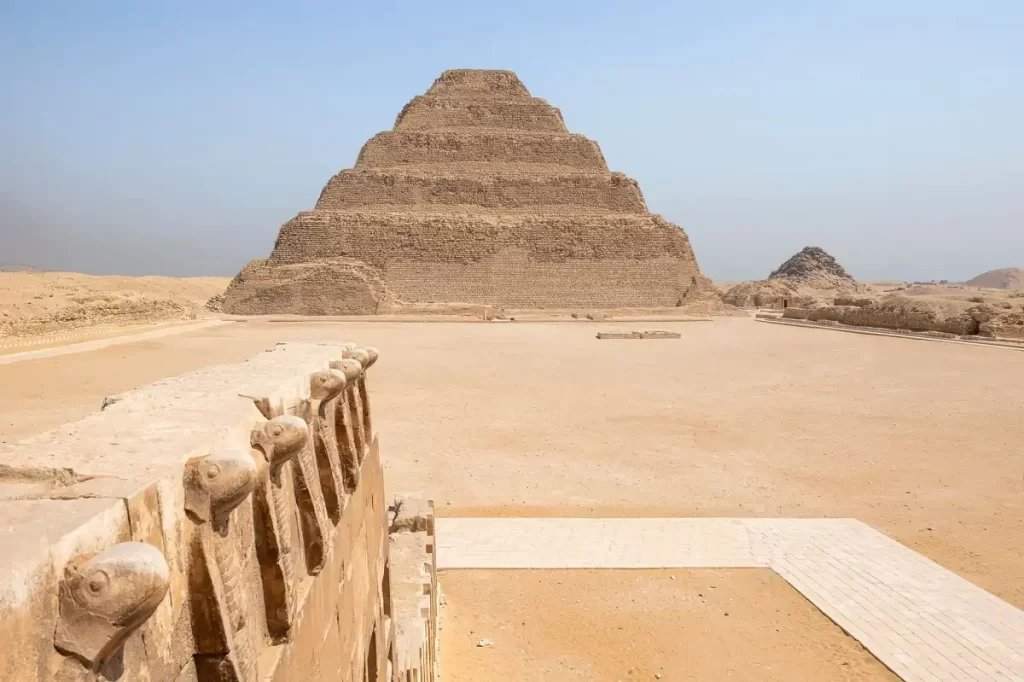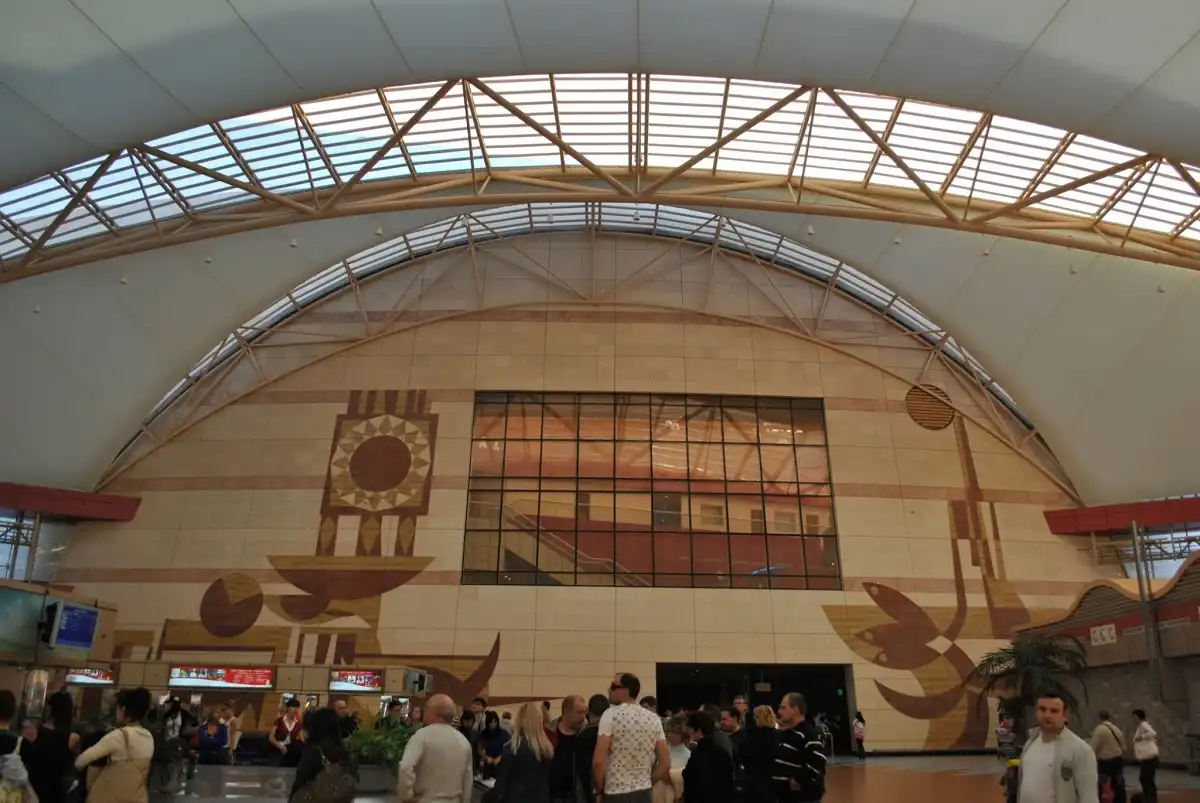
Saqqara Step Pyramid
[ez-toc]
Overview of Saqqara Step Pyramid
The Saqqara Step Pyramid is a time machine that reveals the mindset and ingenuity of the ancient Egyptians as they sought immortality, produced works of art, and paid homage to their gods. The major goal of this essay is to provide all available facts and information regarding the Saqqara step pyramids. A group of expert and qualified tour operators, tour guides, knowledgeable researchers, and travel advisors who are well-versed in all aspects of the magnificent Saqqara Step Pyramid wrote this article.
The Saqqara Step Pyramid, which is credited with sparking a wave of miraculous creations including the three Great Pyramids and a significant advancement in the area of the building, is where the evolution of the pyramids can be followed. The Step Pyramid of Saqqara served as the starting point for the construction of the three Great Pyramids of Giza, which are still regarded as the most important and magnificent works of art and architecture in human history. The Step Pyramid of Saqqara continues to mark an important turning point in the development of stone architecture in Egypt and around the globe.
History
The step pyramid of Saqqara, also known as a proto-pyramid, is thought to be the earliest significant large-scale cut-stone construction ever made in human history. It was built in the third dynasty’s 27th century, or about 4,700 years ago, to serve as Pharaoh Djoser’s (2721–2780 BC) final resting place. The majority of the ancient Egyptian royalty and aristocracy were interred in mastabas, a form of underground funerary building that was typically rectangular in shape and built over the tomb. Djoser wanted to be interred in a brand-new style of building.
It was created by his Vizier “Imhotep,” one of the most clever individuals in ancient Egyptian history, to serve as the focal point of a vast funeral complex in a vast courtyard surrounded by the most magnificent ceremonial structures and exquisite embellishments. He was the first to choose to construct a straightforward mastaba tomb rather than a square-based pyramid inside of a remarkable complex that altered the course of architecture for millennia. In March 2020, the pyramid reopened to the public following 14 years of repair.
Djoser
The Saqqara step pyramids are known as the Pyramid of Djoser, who reigned for 19 years and was known as King Netjerykhet during the Egyptian Old Kingdom (2686-2125 BC). He was the first or possibly the second king of the 3rd Dynasty (2670-2650 BC) and was able to see his step pyramid fully completed. It stands out as an original and the first colossal edifice ever fashioned of stone, which influenced many of his successors. Djoser wanted a special building that was the first of its kind since it used rock-cut limestone instead of mud bricks.
Architecture
The four sides of the Saqqara Step Pyramid are almost exactly lined up with the four cardinal directions. The most significant aspect of the Step Pyramid is that it is the first of its kind. Djoser’s Step Pyramid complex comprised a number of features that were crucial in assisting the monarch in entering the afterlife and experiencing an eternal rebirth. It is encircled by a wall that is 10.5 metres high and has 14 doors and one entrance. The false doors, which functioned as a passageway for the pharaoh’s soul to enter the afterlife, were the entry for the living.
The king’s body lay in state in a tomb located in the centre of a labyrinth of tunnels beneath the base of the Pyramid. The burial chamber, which is 13 feet long and enclosed in granite, contained thousands of stone objects with the names of former monarchs carved on them, but it was sadly looted. A labyrinth with a depth of 28 m, a length of 6 km, and a central shaft measuring 7 sq m exists beneath the pyramid. It is made up of galleries, tiny corridors, and tunnels that are filled with more than 30,000 jars made of various types of stone, including slate, marble, alabaster, and many others, as well as many names of first and second-dynasty pharaohs.
Construction of the Saqqara Step Pyramid
The Saqqara Step Pyramid, the oldest large-cut stone building, is renowned for being a turning point in the development of ancient Egyptian funeral structures and a precursor to the complete revolutionization of stone architecture and royal burials. It has a foundation that measures 109 metres by 125 metres (358 feet by 410 feet) and is constructed of six limestone mastabas stacked on top of one another. Its height is 62 metres (203 ft). The step pyramid’s volume is 330,400 m3 (11,667,966 cu ft).
The step pyramids are connected to central shafts that are 28 metres deep and 7 metres square, which is highly reminiscent of the design of the huge pyramids of Khufu. These shafts extend up to 6 kilometres beneath each step pyramid. The French architect and Egyptologist Jean-Philippe Lauer, who made important findings at the complex and essentially gave rise to our current understanding of pyramid construction, particularly the Step Pyramid Complex, discovered the Step Pyramid in 1926 BC. It was closed for 14 years while it was being restored, and it reopened in March 2020.
Step Pyramid Complex
The complex includes the Step Pyramid, the House of the South, the House of the North, the Heb Sed Court (a celebration is held when a king occupies the throne for 30 years), the Serdab, Temple T, the South Tomb, and the Northern Mortuary Temple, along with the surrounding wall that allowed the king to enter the afterlife and be perpetually reborn. Upper and Lower Egypt are represented by the Houses of the North and the South. The life-sized statue of Djoser, the oldest known life-sized Egyptian statue still in existence and one of significant significance to the king’s soul in the afterlife, may be found in the Serdab (also known as the “cellar”), a limestone building located close to the northern entrance of the pyramid.
The House of the North and the House of the South, each with thirteen tiny chapels, are located in the courtyard. Three carved panels in the South Tomb show Djoser engaging in the Heb Sed ceremony. The building’s outside is modest and unadorned, but the interior has been exquisitely crafted and is supported by Djed pillars. The Colonnade of the complex has 40 columns, known as the style of the engaged column, which are linked to the wall and support the ceiling. Between the colonnade and the complex’s huge number of rooms are statues depicting Djoser as the king of Lower and Upper Egypt.
The Northern Mortuary Temple was utilised to enter the underground tunnels of the pyramid that led to the burial chamber of Djoser, which was a vault made of four layers of well-dressed granite and sealed with a 3.5-ton block. Unfortunately, the vault was looted over time. Five stars that are thought to be connected to the North Star, which is the only star in the sky that never sets, are present on the ceiling of the burial chamber, signifying the pharaoh’s perpetual reign. The Heb-Sed festival, which ensures the pharaoh will rule for the following 30 years, is commemorated on the northern walls with reliefs and artworks depicting the king. There are intricate carvings inside like one of a half-opened door which seems like an actual doorway that represents a symbolic passageway to the afterlife.



